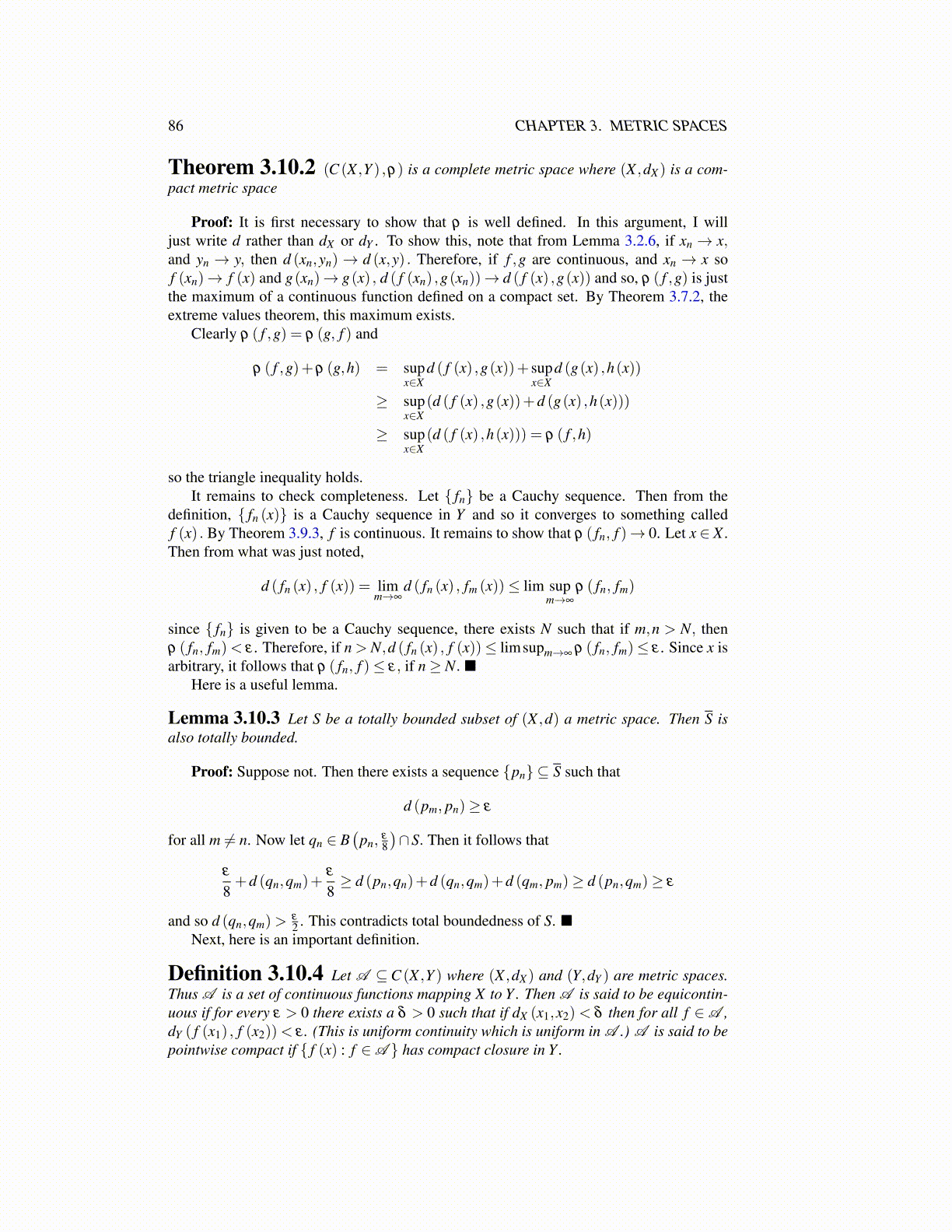
86 CHAPTER 3. METRIC SPACES
Theorem 3.10.2 (C (X ,Y ) ,ρ) is a complete metric space where (X ,dX ) is a com-pact metric space
Proof: It is first necessary to show that ρ is well defined. In this argument, I willjust write d rather than dX or dY . To show this, note that from Lemma 3.2.6, if xn → x,and yn → y, then d (xn,yn)→ d (x,y) . Therefore, if f ,g are continuous, and xn → x sof (xn)→ f (x) and g(xn)→ g(x) , d ( f (xn) ,g(xn))→ d ( f (x) ,g(x)) and so, ρ ( f ,g) is justthe maximum of a continuous function defined on a compact set. By Theorem 3.7.2, theextreme values theorem, this maximum exists.
Clearly ρ ( f ,g) = ρ (g, f ) and
ρ ( f ,g)+ρ (g,h) = supx∈X
d ( f (x) ,g(x))+ supx∈X
d (g(x) ,h(x))
≥ supx∈X
(d ( f (x) ,g(x))+d (g(x) ,h(x)))
≥ supx∈X
(d ( f (x) ,h(x))) = ρ ( f ,h)
so the triangle inequality holds.It remains to check completeness. Let { fn} be a Cauchy sequence. Then from the
definition, { fn (x)} is a Cauchy sequence in Y and so it converges to something calledf (x) . By Theorem 3.9.3, f is continuous. It remains to show that ρ ( fn, f )→ 0. Let x ∈ X .Then from what was just noted,
d ( fn (x) , f (x)) = limm→∞
d ( fn (x) , fm (x))≤ lim supm→∞
ρ ( fn, fm)
since { fn} is given to be a Cauchy sequence, there exists N such that if m,n > N, thenρ ( fn, fm)< ε . Therefore, if n > N,d ( fn (x) , f (x))≤ limsupm→∞ ρ ( fn, fm)≤ ε . Since x isarbitrary, it follows that ρ ( fn, f )≤ ε, if n≥ N. ■
Here is a useful lemma.
Lemma 3.10.3 Let S be a totally bounded subset of (X ,d) a metric space. Then S isalso totally bounded.
Proof: Suppose not. Then there exists a sequence {pn} ⊆ S such that
d (pm, pn)≥ ε
for all m ̸= n. Now let qn ∈ B(
pn,ε
8
)∩S. Then it follows that
ε
8+d (qn,qm)+
ε
8≥ d (pn,qn)+d (qn,qm)+d (qm, pm)≥ d (pn,qm)≥ ε
and so d (qn,qm)>ε
2 . This contradicts total boundedness of S. ■Next, here is an important definition.
Definition 3.10.4 Let A ⊆ C (X ,Y ) where (X ,dX ) and (Y,dY ) are metric spaces.Thus A is a set of continuous functions mapping X to Y . Then A is said to be equicontin-uous if for every ε > 0 there exists a δ > 0 such that if dX (x1,x2)< δ then for all f ∈A ,dY ( f (x1) , f (x2))< ε . (This is uniform continuity which is uniform in A .) A is said to bepointwise compact if { f (x) : f ∈A } has compact closure in Y .